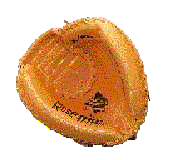
of Catchers
 |
Retired Uniform Numbers of Catchers |
Uniform numbers were first worn by the New York Yankees in the 1929 season to assist the fans in
identifying which players were on the field. [See history of numbers below.] The following are the numbers by organization
of catchers whose numbers have been retired.
| Team | Player | Num | Date Retired |
| Boston Red Sox | Carlton Fisk | 27 | 9/14/1997 |
| Brooklyn (Los Angeles) Dodgers | Roy Campanella | 39 | 6/4/1972 |
| Chicago White Sox | Carlton Fisk | 72 | 9/14/1997 |
| Cincinnati Reds | Johnny Bench | 5 | 1984 |
| Montreal Expos | Gary Carter | 8 | 7/31/1993 |
| New York Yankees | Bill Dickey | 8 | 1972 |
| New York Yankees | Yogi Berra | 8 | 1972 |
| New York Yankees | Thurman Munson | 15 | 1979 |
| New York Yankees | Elston Howard | 32 | 1984 |
| Texas Rangers | Johnny Oates | 26 | 2005 |
It is one of Baseball's most familiar sayings: "You can't tell the players without a scorecard." And
you can't tell the players without numbers. Yet, numbers have not always been a part of a player's uniform. In fact,
they were not used during the 19th century or during the first 15 years of the 20th century. That finally changed in 1916,
when the Cleveland Indians attached small numbers to the sleeves of their uniforms as a way of identifying the players.
Mysteriously, the numbers soon disappeared-without explanation.
On Jan. 22, 1929, the New York Yankees decided to reintroduce the Indians' pioneering uniform feature, but with a twist.
Instead of placing small numbers on their sleeves, the Yankees attached numbers to the backs of their jerseys. The Yankees'
first set of numbers, larger and bolder than the Indians' numbers of 1916, corresponded to each player's general position
in the lineup. In other words, Babe Ruth wore No. 3, since he usually batted third, and Lou Gehrig wore No. 4 as the team's
regular cleanup hitter.
Visible from long distances, the numbers made it easier for fans to distinguish players from their stadium seats - and
easier for play-by-play radio announcers to identify players during their broadcasts.
Unlike previous experiments with numbers, the Yankees' innovation caught on with other teams. By 1932, every one of the
16 major league teams featured numbers on the backs of their jerseys. In fact, numbers have become such an integral part
of the uniform that some of the game's greatest stars are almost as well known by their numbers as they are by their own
names.
